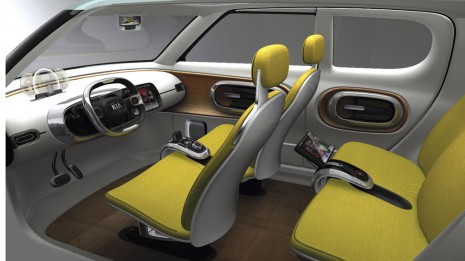In 2011, Kia revealed a concept of what will be one of its most successful electrical cars.
Taking its name from the Korean word “Ne-mo”, (pronounced “Neh-mo”, meaning “square shape”), the Naimo electric crossover utility vehicle (CUV) was conceived by Kia”s international design team in Seoul, and is characterised principally by its simple lines and solid, muscular stance.
The simple overall design is accentuated by a number of striking key details, such as the wrap-around windscreen and asymmetric sunroof, and the front and rear dot-style LED head- and positioning-lamps. This mix of simple and complex is a common trait of many traditional Korean arts and crafts.
Kia”s design team also made use of innovative technology to give the car a premium feel and to ensure the car”s exterior remained uncluttered. For example, Naimo has no traditional wiper blade on the windscreen – instead it employs a high-intensity air jet at the base of the windscreen that performs an “air wiper” function. Conventional door mirrors have also been replaced with miniature cameras installed in the A-pillars.
Naimo”s interior was designed to evoke a strong sense of tranquility and features hand-crafted materials throughout. Korean oak is u
sed to trim the interior door panels and the entire interior floor, Korean “Han-ji” paper is used for the head lining. Alongside these traditional elements sit modern features such as a transparent organic light emitting diode display instrument panel and full connectivity.
The third electric vehicle design to be unveiled by Kia Motors Corporation in a year, the 3.9-metre long Naimo concept explores the practicalities of introducing a zero-emissions, five-door, four-seater city car into a future niche market.
Measuring 3,890 mm in length, the Naimo”s generous wheelbase, width and height (2,647, 1,844 and 1,589 mm respectively) – plus the short overhangs which place a wheel at each corner – ensure that the cabin provides exceptional head, leg and shoulder room for the occupants.
The concept car has no B-pillars and features rear-hinged rear doors to maximise easy access to the cabin, and a three-way split opening boot-lid, allows versatile access to the load bay for varying luggage sizes.
Power comes from a Permanent Magnet Synchronous Motor with a maximum output of 80 kW (109 ps) and maximum torque of 280 Nm, enabling Naimo to reach a top speed of 150 kph (93 mph).
A twin-pack 27 kWh battery is located under the boot floor and uses innovative Lithium Ion Polymer technology that offers numerous advantages over other battery types. Equipped with this battery, Naimo provides a driving range of 200 km (124 miles) on a single charge. To enhance range, the showcar is fitted with special low-drag 20-inch diameter alloy wheels.



